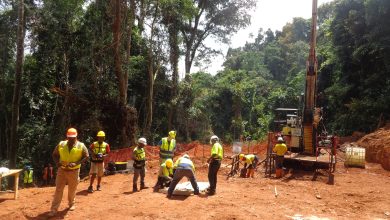
Kidnap and ransom insurance for expatriates involved in mining projects
Duty of care for employees in high-risk areas
In the past three years, the level of kidnap and ransom risk in some regions in Africa has been escalating alarmingly. Doubtless, this is a clarion call for mining companies to be well-equipped to effectively deal with possible cases of abductions their employees deployed for duty in those areas may face.
As part of adherence to good corporate governance, mining companies have an obligation to guarantee the safety of their employees. And one of the ways is through taking out Kidnap and Ransom Insurance Policies.
Recent reports of deterioration in security and geopolitical volatility in a number of territories in West Africa and more recently in East and Southern Africa underscore significant security risks that mining companies with operations in these areas face. West Africa in particular is notorious for cases of kidnappings and ransom. Clearly, the onus is on the respective mining companies to invest in initiatives that can guarantee the safety of employees.
Currently, mining companies are seeking cost-effective alternatives to what are generally regarded as traditional ways of doing business from their pit to port operations. So, could a similar approach be applied to managing the escalating risk of kidnap and ransom?

Comprehensive kidnap and ransom insurance
Unfortunately, thus far, there is no approach that has been established to be effective exclusively – if any – in addressing the risk of kidnap and ransom. So far, including comprehensive kidnap and ransom insurance as an integral part of a mining company’s human resources management has proved to be most effective.
Hence, at the outset, it is paramount to grasp vital elements in kidnap and ransom risks that affect employees that may be considered making decisions.
Areas of interest
Information gathered from a questionnaire sent out to leading brokers and insurers that provide kidnap and ransom insurance to clientele in African countries paints a vivid picture of trends in the contemporary kidnap and ransom insurance arena. Prominently, the following emerge as main areas of interest: The modus operandi employed in Kidnap and Ransom; the Vulnerability of Employees; Policy Relevance; Scope of Coverage; and Informed Advice.
Two industry authorities encapsulate the views of their peers in these above-mentioned areas. Mark Doust is the Regional Director of Special Contingency Risks (SCR), a firm that provides specialised services to clients in the insurance and management of kidnap and extortion, political evacuation events, risk mitigation and general security in the Middle East and Africa (MEA) regions. David Tompkins is President of Vancouver-based TFG Global Insurance Solutions Ltd., one of the leading insurance broking firms that has been serving global mining companies with operations in high-risk areas including Africa.
- The modus operandi employed in kidnap and ransom
Having studied trends and consulted for clientele, Doust describes the typical modus operandi that criminals employ and the assistance rendered through an insurance policy: “Typically, after an employee is taken hostage, abductors ask for a huge sum of money to be paid as a ransom. And to address the crisis, major costs incurred that cover the consultant’s professional assistance; supporting the client with negotiations with the abductors; and general incident response. These can reach millions of dollars. Negotiations are a complicated process involving local law enforcement, host and foreign governments, the media, family members, lawyers and many other stakeholders.”
Nevertheless, it must be stressed that payment of a ransom to proscribed terrorist groups to resolve a hostage crisis is deemed illegal under international law. In actual fact, it is illegal to negotiate with terrorist organisations or hostage takers.
- Employee susceptibility
Urging organisations to take kidnap and ransom insurance coverage for their employees is not being alarmist. Actually, their employees are more susceptible due to their standing. Criminal gangs – usually members of an organised criminal group, terrorist group or a local militia – may deliberately target expatriates and other foreigners expecting to get a more lucrative ransom from insurance.
These employees are deployed in some of the regions in which conditions provide fertile ground for kidnap and ransom activities. In the respective regions, typically, political systems are unstable, law enforcement agencies are weak or under-resourced and government officials are corrupt.

- Scope of coverage
Traditionally, to help mining companies manage the risk of kidnap and ransom incidents, insurers underwrite for overall policy coverage mainly reimbursement of ransom, crisis consultancy fees and expenses and limited special expenses. However, due to the evolving nature of risks, insurers have extended underwriting to mitigating serious risks to employees beyond traditional kidnapping for ransom, including post-incident crisis management support, business interruption (as a result of both physical and non-physical damage), reputational and financial consequences.
Commendably, through this approach, insurers can meet contemporary challenges. Actually, it is critical that an insurance package has a wide scope of coverage to address the unique risks that an organisation’s employees may be exposed to. A case in point could be an area like the trauma that a victim experiences during the duration of the abduction, which traditional packages may not address adequately. Traditional insurance packages may overlook the reality that a victim can live with the trauma of a hostage crisis for a long time.
For this reason, current insurance packages should be structured in such a way that they enable the employee to return to normal life routine, Doust states. “If not well managed, the traumatic experience can alter someone’s life forever. Offering psychological support for six months then leaving the employee to his or her own devices may not suffice,” he observes, stressing that coverage for post-incident trauma is fundamental.
- Policy Relevance
Seeing that there are hundreds of insurance cover packages out there, from a broker’s perspective, Tompkins tells organisations to thoroughly establish if a product before them could best serve their exact needs (relevance). Mainly, he informs mining companies to beware of what are punted as ‘convenient’ off-the-shelf insurance packages.
“Unfortunately, in most cases, off-the-shelf insurance turns out to be piecemeal coverage in the form of business travel medical and evacuation plans from travel agencies, or even retail entities. This piecemeal coverage can fall short as services may not be rendered as required, becoming a potential risk in itself.”
Instead, Doust chirps in, mining companies should secure insurance plans to provide robust emergency medical, evacuation and repatriation coverage for short-term trips. “Mines should avoid asking employees to source their own coverage, as the coverage they source as individuals will often be more expensive, and not as robust as a group policy.”
Moreover, mining companies should avoid thinking that insurance cover is a cure-all for all risks that employees are exposed to, Doust adds. This is because coverage cannot compensate for an organisation’s lapses in sound health, safety and security management, he elaborates.
- The Mining Company’s Obligation
Essentially, the obligation falls on mining companies to prioritise investment in measures that ensure adequate health, safety and security for their employees, as much as their main focus is their core businesses. More often than not, insurance companies do not want to underwrite risks, which, in most part, result from the client’s lapse or failure to demonstrate robust basic measures when it comes to protecting their people. Markedly, insurer appetite has and is changing, with underwriters becoming more selective on what they choose to quote on and what level of cover they are willing to offer.
“Due to the evolving nature of liabilities, underwriters are asking the client more questions before entering into a contract. For instance, the client should have a detailed plan, documenting evidence of thorough planning to ensure employee protection. In a nutshell, certain measures will have to be taken to identify risk and mitigate risk inhouse,” Tompkins points out. Some of the initiatives to best mitigate risks in may involve pre-incident training, pre-travel and security awareness briefings as part of the standard pre-departure operating procedure.
- Informed advice
The last thing mines would loath to experience is being caught unawares in times of urgent need – belatedly realising that their insurance packages fall short. For this reason, decisions on insurance packages should be based on informed advice after consulting a credible broker. “It is wise to have a central point of contract of a broker that can provide legal advice on assessing the client’s respective level of exposure in a possible crisis situation and finding an appropriate solution to meet their needs,” Tompkins emphasises.
“It is worthwhile that only underwriters that are ahead of global trends should be engaged. This necessitates a client seeking expert legal advice in assistance with reviewing their exposure in a possible crisis situation and finding an appropriate solution to meet their needs,” he adds.
Compliance with sound corporate governance
Taking out suitable insurance for employees is a duty of care for mining companies, as it underlines a commitment to compliance with sound corporate governance. Insurance is vital in the management of exposure of employees to risks. It is about being well-equipped in preparing for incidents of threat to employees and responding effectively when they occur.
A necessity
By and large, kidnap-and-ransom insurance has become a necessity more than ever. This is due to increase in joint ventures globally, which has resulted in employees being assigned for work in volatile regions where the risk of kidnap and ransom incidents is high.
Side bar 1
Sub-Saharan Africa – a hotspot of kidnap and ransom
- In Nigeria, staff from mining, oil and development sectors face a rise in kidnap activity from insurgents, specifically in Borneo, Kaduna and Delta states.
- The Democratic Republic of Congo, Somalia and South Sudan are the countries of highest danger.
- Security in Mali’s northern and central regions remains poor. In the country, several criminal and jihadist organisations, including al-Qaeda-affiliated groups, have set up camp.
- Recently, Mozambique has emerged as another hotspot. Terrorist attacks have resulted in indefinite closure of gas projects worth billions of dollars.
Side Bar
The risk of Kidnap and Ransom real, not perceived
Statistics of incidents recorded between 2016 and 2021 illustrate that the prevalence of the risk of abductions is real, not perceived. The following ranks amongst some of the high-profile incidences:
- June 2016 – Abduction of seven employees of Macmahon Holdings, an Australian mining and services company, at gunpoint from a worksite in Nigeria. The employees were held for five days until the company secured their release. The driver was killed during the attack
- 02 Mar 2017 – Five workers were kidnapped from Banro Mining Corp.’s Namoya mine in eastern Congo and rebels demanded $1 million in ransom. Their nationalities included Congolese, Tanzanian and French.
- October 2019: A gang of men armed with automatic rifles took company employees hostage at DRDGold’s Ergo operation near Brakpan, east of Johannesburg. The company’s chief security officer, Bart Coetzee, was shot dead. The gang escaped with 17 kg of gold in concentrate worth about R12-million.
- 17 Dec 2019 – Kirk Woodman, who worked for Vancouver-based Progress Minerals Inc., was found dead in Burkina Faso’s Oudalan province.
- April 2021- Two Chinese workers were kidnapped from a gold mine site in Nigeria’s southwestern Osun state. The criminals also shot and injured two private guards.
- June 2021 -Chinese miners were abducted in Niger near the country’s border with Mali and Burkina Faso, a hotbed for Islamists (Detschwelle)
- July 2021 – Gunmen kidnapped six workers of West African Ceramic Company in Ajaokuta Local Government Area of Kogi State, where the company mines stones (Premium times Nigeria)
In fact, between 2017 and 2019, an estimated 80% of workers in the extractive sector – including mining, oil and gas exploration, dredging and quarrying – in Sub-Saharan Africa were kidnapped, according to 2020 Travel Security Special Edition: Held to Ransom: Kidnapping and Extortion in the Extractive Sector.
The 2020 Travel Security Special Edition also noted that, in terms of the number of foreign nationals targeted, sub-Saharan Africa remains the highest-risk destination, followed by the Middle East and North Africa (MENA) and Latin America.
2021 Kidnap and Ramson Insight, published by Constellis, reveals that over the first two months of 2021, Africa recorded an increase of 26% in foreign victims, compared to November/December 2020.






